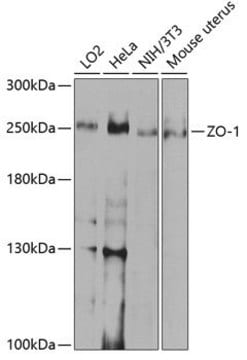MAB4369
Anti-SRF [Serum Response Factor] Antibody, clone 1E1
clone 1E1, from mouse
Synonym(e):
serum response factor (c-fos serum response element-binding transcription factor)
About This Item
Empfohlene Produkte
Biologische Quelle
mouse
Antikörperform
purified antibody
Antikörper-Produkttyp
primary antibodies
Klon
1E1, monoclonal
Speziesreaktivität
mouse, human
Methode(n)
immunocytochemistry: suitable
western blot: suitable
Aufnahme
sample type neural stem cell(s)
sample type mesenchymal stem cell(s)
Isotyp
IgG1κ
UniProt-Hinterlegungsnummer
Versandbedingung
wet ice
Posttranslationale Modifikation Target
unmodified
Angaben zum Gen
human ... ELK3(2004)
Allgemeine Beschreibung
Spezifität
Immunogen
Anwendung
Stammzellforschung
Mesenchymale Stammzellen
Neurale Stammzellen
Qualität
Western Blotting: Recommended working dilution is 0.5 µg/mL.
Zielbeschreibung
Physikalische Form
Lagerung und Haltbarkeit
Sonstige Hinweise
Haftungsausschluss
Not finding the right product?
Try our Produkt-Auswahlhilfe.
Lagerklassenschlüssel
12 - Non Combustible Liquids
WGK
WGK 1
Flammpunkt (°F)
Not applicable
Flammpunkt (°C)
Not applicable
Analysenzertifikate (COA)
Suchen Sie nach Analysenzertifikate (COA), indem Sie die Lot-/Chargennummer des Produkts eingeben. Lot- und Chargennummern sind auf dem Produktetikett hinter den Wörtern ‘Lot’ oder ‘Batch’ (Lot oder Charge) zu finden.
Besitzen Sie dieses Produkt bereits?
In der Dokumentenbibliothek finden Sie die Dokumentation zu den Produkten, die Sie kürzlich erworben haben.
Unser Team von Wissenschaftlern verfügt über Erfahrung in allen Forschungsbereichen einschließlich Life Science, Materialwissenschaften, chemischer Synthese, Chromatographie, Analytik und vielen mehr..
Setzen Sie sich mit dem technischen Dienst in Verbindung.








